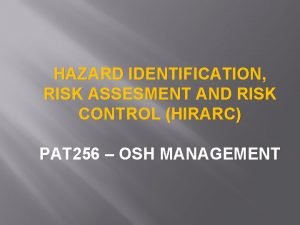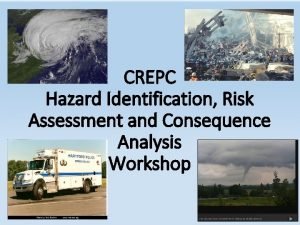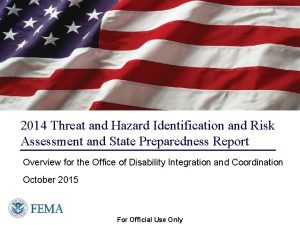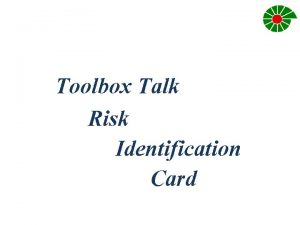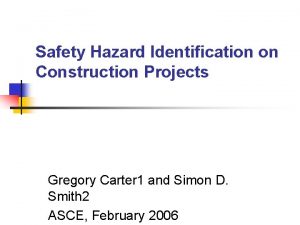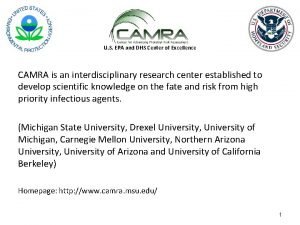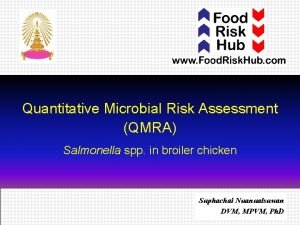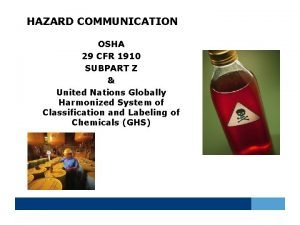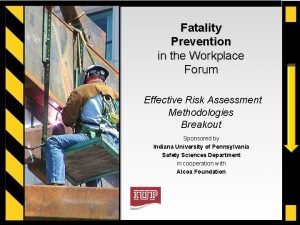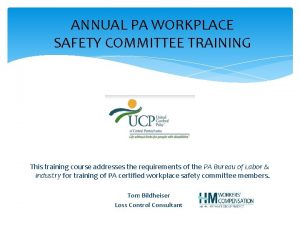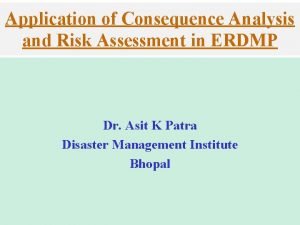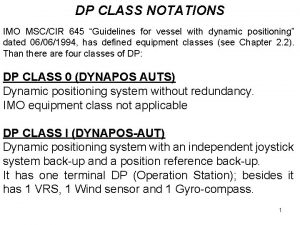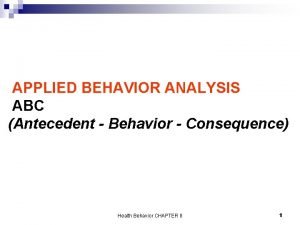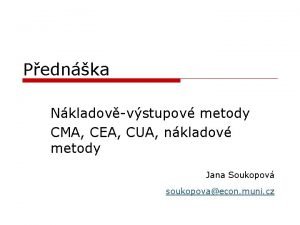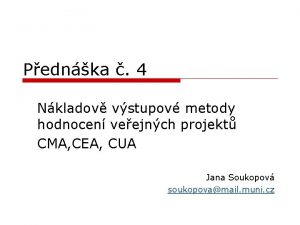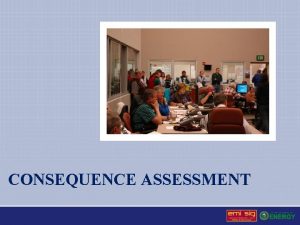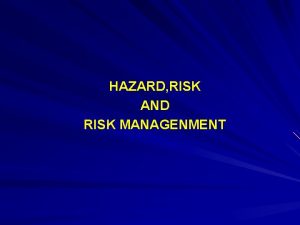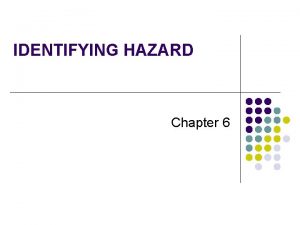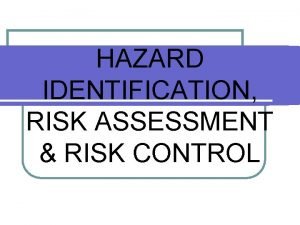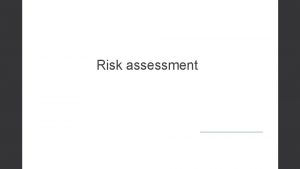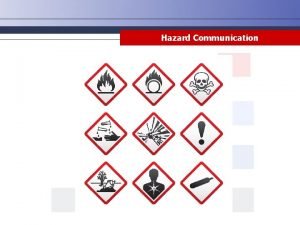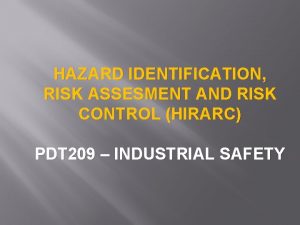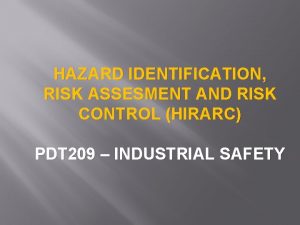CREPC Hazard Identification Risk Assessment and Consequence Analysis



















- Slides: 19

CREPC Hazard Identification, Risk Assessment and Consequence Analysis Workshop

Purpose The purpose of this workshop is to identify the natural and human-caused hazards that potentially impact the Division of Emergency Management and Homeland Security Region 3 (DEMHS R-3). Also known as the Capitol Region

Overview • • • Developmental Process Review of Development Tables Hazard Identification Tables 1. 1 & 1. 2. 1 Risk Assessment Table 1. 2. 2 Hazard Vulnerability Assessment Table 1. 3

Developmental Process The Emergency Management Accreditation Program (EMAP) Committee of CREPC researched and obtained the following documents in the development of this assessment and analysis. • State of Connecticut Department of Emergency Services and public Protection/Division of Emergency Management and Homeland Security Connecticut’s Hazard Identification • Risk Assessment and Consequence Analysis, State of Connecticut Natural Hazard Mitigation Plan (2014) • • Capitol Region Natural Hazards Mitigation Plan (2014) • • • The Department of Homeland Security (DHS) required Threat and Hazard Identification Risk Assessment (THIRA) (2012) The State of Connecticut Natural Disaster Plan (2009) Other Regional and Local Emergency Operation Plans for the Connecticut’s DEMHS R-3 municipalities State of Connecticut Catastrophic Disaster Plan (2009) DEMHS Web Site Capitol Region Emergency Support Plan State of Connecticut Disaster Debris Management Plan (2013) Connecticut Climate Change Preparedness Plan (2011) State of Connecticut Dam Safety Program DHS 2013 Fusion Center Assessment Individual Report: Connecticut Intelligence Center.

Developmental Process The Committee then consolidated the hazards from these documents. As a result, three primary tables have been developed: • Table 1. 1 Identified hazards and potential for the hazard to occur using assigned rankings of “likely”, “possible”, and “not likely” • Table 1. 2. 1 Hazard Identification and Risk Assessment (HIRA) • Table 1. 3 Capitol Region Hazard and Vulnerability Assessment

Discussion: Identified hazards and potential for the hazard to occur A review of all the hazards listed in the documents above resulted in an initial list of over 50 possible hazards. This list was presented to the CREPC EMAP committee and through discussion this list was further refined and grouped into similar hazards and then determined to be considered “likely, ” “possible, ” or “not likely” to have an impact on the Capitol Region. Table 1. 1 provides a listing of the 25 ranked hazards. Of the total, there were 19 that were ranked “likely”, six ranked “possible. ” It should be noted that some planning documents have listed “Lost/missing persons, ” “mass evacuation incident, ” and “space weather” as possible hazards, however these are not included in the further analysis that was conducted for tables 1. 2. 2 and 1. 3. For example “Lost/missing persons” and “mass evacuation incident” are considered a secondary action that may be tied to one or more of the hazards listed below. The term “space weather” refers to the variable conditions on the sun and in space that can influence the performance of technology used on Earth. Therefore for purposes of this hazard analysis “space weather” is included under cyber incident.

Table 1. 1 Hazard Identification


Discussion: Hazard Identification and Risk Assessment (HIRA) In addition to identifying natural and human-caused hazards, the CREPC Stakeholders and EMAP committee conducted a risk assessment to determine the potential impact of the hazards. A risk assessment is the process of measuring the potential loss of life, personal injury, economic injury, and property damage resulting from potential hazards. The focus of the risk assessment is to identify what natural and human caused hazards are present in the region and the potential impacts of those hazards and threats. Each hazard was evaluated individually and given a numerical value, as shown in the table below, to assess and quantify the hazard that may impact the region. The table provides definitions in their associated point value system that was created by the DEMHS staff during the States evaluation process. Table 1. 2. 1 shows the category, description, and point system that were used in creating Table 1. 2. 2.

Table 1. 2. 1 Category, description, and assigned values for hazard identification and risk assessment. DEMHS, March 2014





• Hazard Vulnerability Assessment Table 1. 3


QUESTIONS ?

THANK YOU

 Flowchart of hirarc process
Flowchart of hirarc process Crepc2
Crepc2 Hazard identification table
Hazard identification table Threat and hazard identification
Threat and hazard identification Cause consequence analysis
Cause consequence analysis Market risk assessment
Market risk assessment Toolbox talk risk assessment
Toolbox talk risk assessment Safety hazard identification on construction projects
Safety hazard identification on construction projects Hazard identification
Hazard identification Hazard identification
Hazard identification 3 ingredients for fire
3 ingredients for fire Awair training
Awair training Hiraclite
Hiraclite Hazard identification
Hazard identification Identify hazards
Identify hazards Consequence analysis example
Consequence analysis example What are dp classes
What are dp classes Antecedent behavior consequence analysis
Antecedent behavior consequence analysis Metoda cua
Metoda cua Cost consequence analysis
Cost consequence analysis
